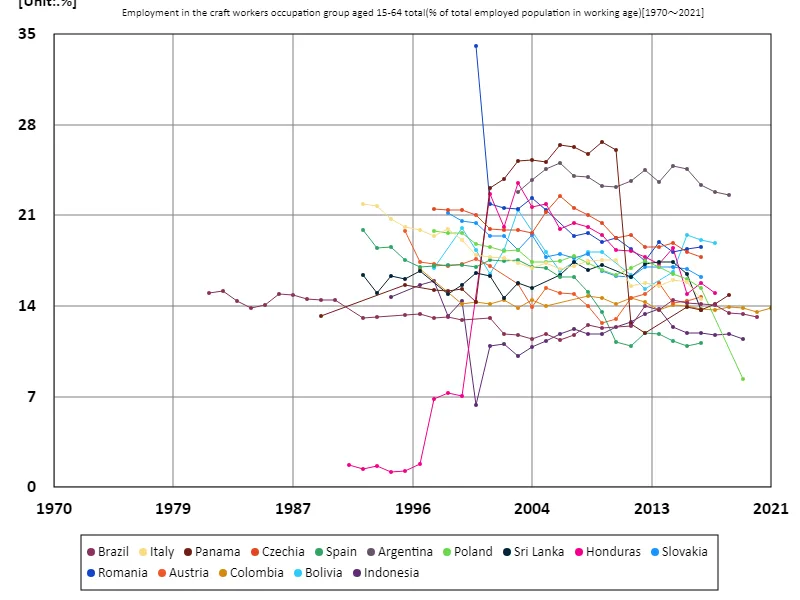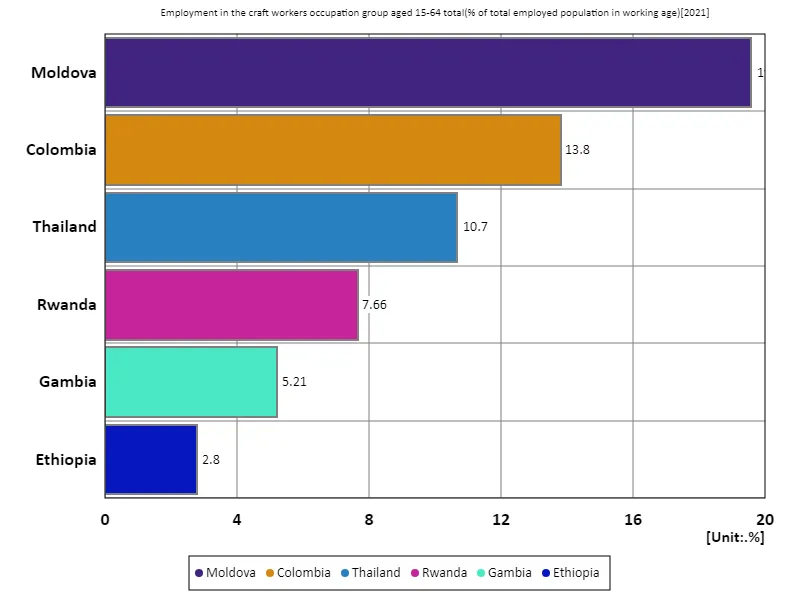- Abstract
- Employment rate of craft occupations for all 15-64 year olds (percentage of working-age employed population)
- Employment rate of craft occupations for all 15-64 year olds (percentage of working-age employed population) (Worldwide)
- Employment rate of craft occupations for all 15-64 year olds (percentage of working age employed) (Worldwide, latest year)
- Reference
Abstract
In recent years, employment trends in global craft occupations have shown variability, with countries like Brazil experiencing higher participation. In 2020, Brazil’s craft occupation employment rate for the 15-64 age group was the highest at 13.2%. This indicates a significant portion of the working-age population engaged in craft-related jobs, reflecting the country’s strong informal sector and cultural emphasis on artisanal work. Over the past decades, such occupations have been more prominent in developing economies, often due to limited formal job opportunities, while industrialized nations saw a shift toward service-based employment.
Employment rate of craft occupations for all 15-64 year olds (percentage of working-age employed population)
From 1981 to 2020, global trends in the employment rate for craft occupations (as a percentage of the working-age population) have fluctuated significantly. Romania led in 2000 with a peak rate of 34%, reflecting a strong reliance on traditional crafts and informal sectors. However, by 2020, Romania’s rate had decreased to 54.4% of its peak, mirroring a broader global shift. As economies industrialized and urbanized, many countries saw a decline in craft occupations, with more workers moving into service and technology sectors. Yet, in some regions, craft jobs remain crucial for cultural heritage and local economies.


The maximum is 34%[2000] of Romania, and the current value is about 54.4%
Employment rate of craft occupations for all 15-64 year olds (percentage of working-age employed population) (Worldwide)
From 1981 to 2021, the global employment rate in craft occupations for the 15-64 age group has seen notable shifts. Romania recorded the highest rate in 2000 at 34%, driven by its strong craft and informal sectors. However, by 2021, Romania’s rate had fallen to 54.4% of its peak, reflecting the broader global trend of industrialization and urbanization, which reduced reliance on traditional craft jobs. As economies modernized, many workers transitioned to service and technology sectors. Nevertheless, craft occupations remain vital in some regions, preserving cultural heritage and supporting local economies.


The maximum is 34%[2000] of Romania, and the current value is about 54.4%
Employment rate of craft occupations for all 15-64 year olds (percentage of working age employed) (Worldwide, latest year)
In 2021, Moldova led the global employment rate for craft occupations within the 15-64 age group, reaching 19.6%, well above the global average of 9.95%. This highlights Moldova’s reliance on traditional crafts and informal labor sectors, a trend common in many developing economies. Globally, 59.7% of countries reported craft occupation rates below the average, indicating a shift towards industrial and service sectors as economies modernize. While craft occupations remain important in some regions for cultural and economic reasons, global trends suggest a decline as more workers transition to formal employment in urbanized economies.


The maximum is 19.6% of Moldova, the average is 9.95%, and the total is 59.7%



Comments